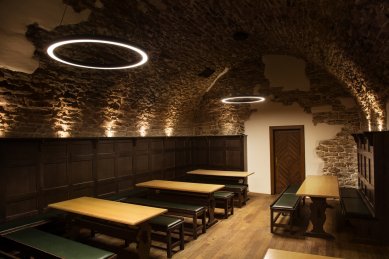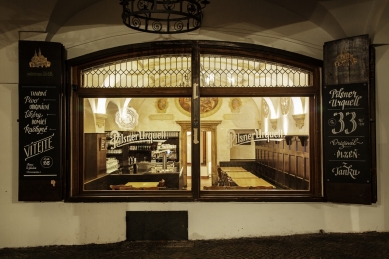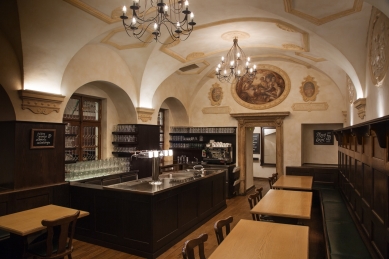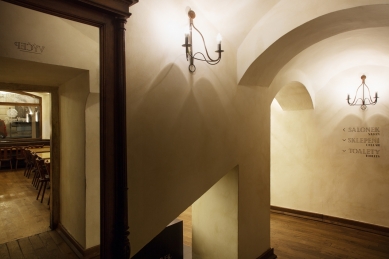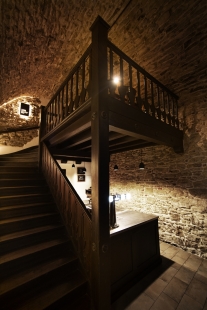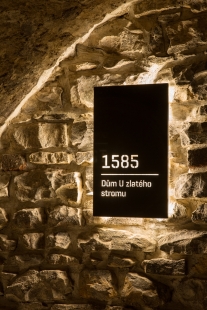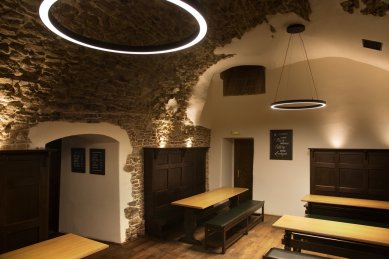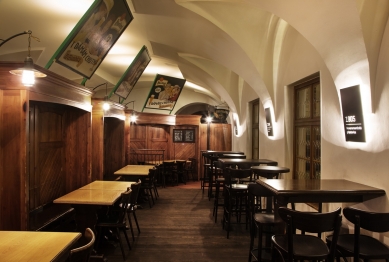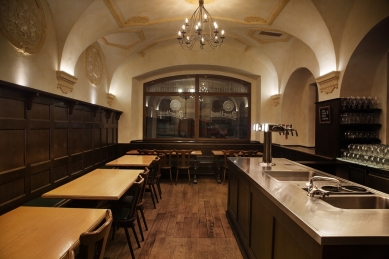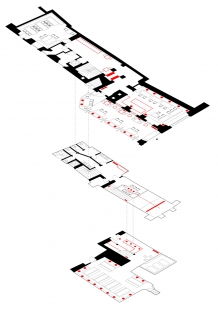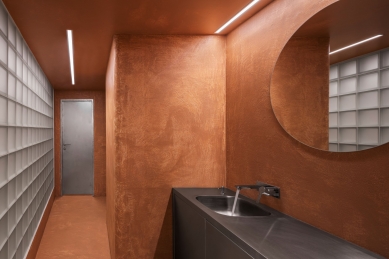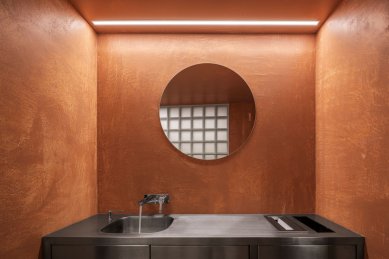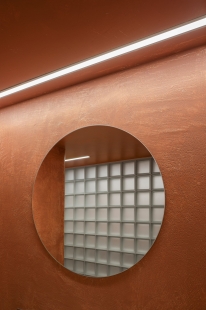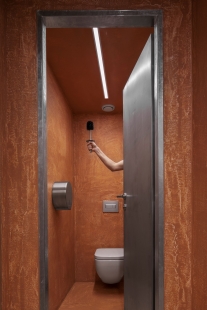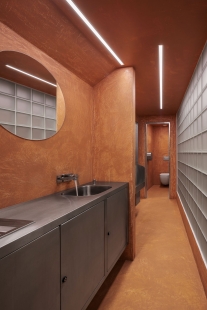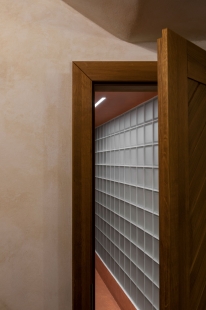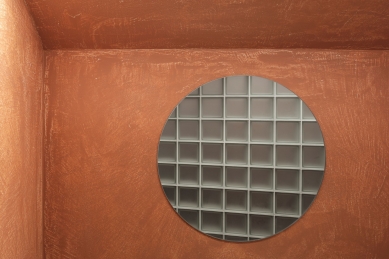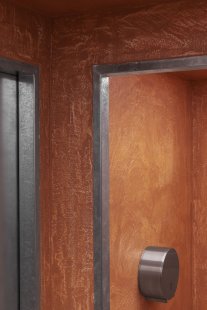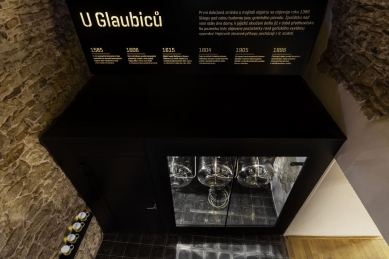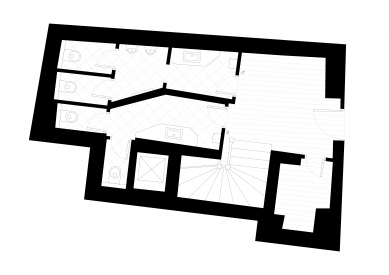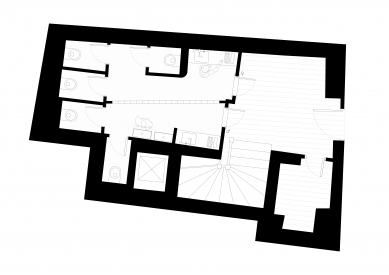
Revitalization of the U Glaubiců Restaurant

We were approached to propose a complete revitalization of the interior that would not compromise the traditional character and would enhance the overall level and capacity of the famous pub. The challenging search for the ideal combination of old and new led to a very sensitive approach based primarily on changing the atmosphere and making acupuncture-like interventions.
The documented history of the Malostranský house U Glaubiců dates back to 1389, and at the turn of the millennium, the dilapidated cultural monument underwent a salvaging reconstruction. The condition of the restaurant of the same name was functional, but far beyond the threshold of moral viability: two decades of uncoordinated modifications resulted in inappropriate colors, lighting, details, and objects in the form of pseudo-historic or slightly tasteless decorations, fixtures, advertisements, etc. We cleaned the entire space of ballast elements and subsequently unified it with wall painting, furniture, lighting, information systems, and quality details. Everything meaningful was preserved. The only new, entirely contemporary interventions are defined by black steel. Specifically, these include standing counters with fine details and a system of informational light fixtures that guide guests through the most important dates from the entrance to the cellar, where it culminates in a levitating panel summarizing the history of the building. In place of the ceiling opening, a minimalist informal seating area adorned with palindromes expands.
The biggest operational problem was represented by both taps. Their revitalization and expansion were carried out in a traditional spirit, which also applies to minor adjustments to the layout. The existing furniture and lighting that define the contemporary character of the pub were preserved to the highest possible degree and complemented without contrast. Indirect lighting and a unified orientation-communication system of handwritten signs and lettering on the walls were added. The significant dimming and adjustment of the lighting emphasized the atmosphere and the distinct character of the Gothic cellar. Historically relevant painted walls in suitable colors replaced the overly bright shades. A part of the bench that was cut off to expand the tap was reused in front of the restrooms instead of a worn-out sofa. Chamfered corners replaced plastic strips. Simple black circles replaced overdecorated knightly chandeliers. Electrical wiring was hidden, and plastic switches and sockets were replaced with ceramic ones. The project was consulted with heritage conservationists, a restorer, and the architect of the last reconstruction from 1998. Daily presence on the construction site during the challenging reconstruction operation was crucial, as was collaboration with great craftsmen.
Three years after the complete revitalization of the interior, which we finished at U Glaubiců in 2017, the owner asked us to return to the scene: the worn-out restrooms and one of the first beer taps in Prague had been in operation since the late 1990s. Replacing the inadequate wooden tap with an elegant black box matching our previous interventions was not a problem— the fundamental challenge was addressing the restrooms. Due to the constraints of the historical building, they operated in minimal space, and queues often formed, but thanks to an elegant rearrangement of the layout, we managed to add an extra restroom for ladies and significantly improve service for gentlemen.
The artistic solution intentionally contrasts with the rest of the pub, and visitors enter a distinctive, compact red space dominated by a dividing wall made of translucent yet opaque glass blocks. The atmosphere is complemented by stainless steel fixtures, recessed linear lighting, and round mirrors. The construction work required a complete interruption of operations, so it was an important part of the project to plan and coordinate the construction execution so that the entire renovation could be completed within two weeks.
The documented history of the Malostranský house U Glaubiců dates back to 1389, and at the turn of the millennium, the dilapidated cultural monument underwent a salvaging reconstruction. The condition of the restaurant of the same name was functional, but far beyond the threshold of moral viability: two decades of uncoordinated modifications resulted in inappropriate colors, lighting, details, and objects in the form of pseudo-historic or slightly tasteless decorations, fixtures, advertisements, etc. We cleaned the entire space of ballast elements and subsequently unified it with wall painting, furniture, lighting, information systems, and quality details. Everything meaningful was preserved. The only new, entirely contemporary interventions are defined by black steel. Specifically, these include standing counters with fine details and a system of informational light fixtures that guide guests through the most important dates from the entrance to the cellar, where it culminates in a levitating panel summarizing the history of the building. In place of the ceiling opening, a minimalist informal seating area adorned with palindromes expands.
The biggest operational problem was represented by both taps. Their revitalization and expansion were carried out in a traditional spirit, which also applies to minor adjustments to the layout. The existing furniture and lighting that define the contemporary character of the pub were preserved to the highest possible degree and complemented without contrast. Indirect lighting and a unified orientation-communication system of handwritten signs and lettering on the walls were added. The significant dimming and adjustment of the lighting emphasized the atmosphere and the distinct character of the Gothic cellar. Historically relevant painted walls in suitable colors replaced the overly bright shades. A part of the bench that was cut off to expand the tap was reused in front of the restrooms instead of a worn-out sofa. Chamfered corners replaced plastic strips. Simple black circles replaced overdecorated knightly chandeliers. Electrical wiring was hidden, and plastic switches and sockets were replaced with ceramic ones. The project was consulted with heritage conservationists, a restorer, and the architect of the last reconstruction from 1998. Daily presence on the construction site during the challenging reconstruction operation was crucial, as was collaboration with great craftsmen.
Three years after the complete revitalization of the interior, which we finished at U Glaubiců in 2017, the owner asked us to return to the scene: the worn-out restrooms and one of the first beer taps in Prague had been in operation since the late 1990s. Replacing the inadequate wooden tap with an elegant black box matching our previous interventions was not a problem— the fundamental challenge was addressing the restrooms. Due to the constraints of the historical building, they operated in minimal space, and queues often formed, but thanks to an elegant rearrangement of the layout, we managed to add an extra restroom for ladies and significantly improve service for gentlemen.
The artistic solution intentionally contrasts with the rest of the pub, and visitors enter a distinctive, compact red space dominated by a dividing wall made of translucent yet opaque glass blocks. The atmosphere is complemented by stainless steel fixtures, recessed linear lighting, and round mirrors. The construction work required a complete interruption of operations, so it was an important part of the project to plan and coordinate the construction execution so that the entire renovation could be completed within two weeks.
The English translation is powered by AI tool. Switch to Czech to view the original text source.
0 comments
add comment



